
by Jeanne Preisler
“A smile can make all the difference.”
I bet you have heard that expression before. Smiles are powerful. For most of us, our day gets a little brighter when someone smiles at us. You may have even heard that smiles can be detected over the phone. A study from the University of Portsmouth demonstrated we actually can “hear” a smile in a person’s tone of voice. Smiling is usually the best approach.
Usually, but not always. Imagine you are a 6-year-old girl. A stranger (a social worker) just removed you from the only home you have ever known. You are in a strange car. You’re away from your parents and don’t know what is happening with them. No one thought to pack your favorite stuffed animal and you have no idea how you will fall asleep without it.
You are scared, worried, and numb from all the chaos that has happened over the last few days. The car stops in a neighborhood that looks nothing like yours. The social worker takes your hand and walks you up to a house. Your heart is aching for your stuffed animal so much you can actually hear your heartbeat. It’s beating fast, which makes you even more worried.
Knock. Knock. A woman and man open the door. They’re smiling from ear-to-ear. They’re so happy to see you, they are beaming!
If you are that 6-year-old girl, what thoughts and feelings will you have when you see two strangers with big smiles on their faces—when your world has just fallen apart?
Matching Our Reactions to the Child’s Situation
It’s important to match our reactions—even our facial expressions—to the child’s situation. A warm, slight smile might be an appropriate way to greet our 6-year-old girl, but a broad, joyous smile is not.
In this article I would like to explore how, as resource parents and social workers, we can use our reactions—both to everyday events and to momentous ones, like reunification or graduation—to support young people’s social and emotional well-being.
Our Body Language Is Often Shouting
When social workers started asking young people specific questions about their trauma histories, they began to tell us about events they hadn’t talked about before. Some of these events had to do with why the child entered foster care, but many had nothing to do with child abuse or neglect. They were just scary things these children had experienced. When we asked young people why they hadn’t told us before about these scary events they often said they didn’t think we could handle it.
Even if we don’t say it out loud, young people can sense when we are hesitant to talk about the traumas they have experienced. Whether we are a foster parent, social worker, or other caregiver, children can read our body language quite well.
But young people often misinterpret our trepidation. They may incorrectly think, What happened to me was really, really bad. This adult is stressed out enough, telling my story may send them over the edge. I better not share what happened. They haven’t heard stories as bad as mine before.
Of course, this is not what we are thinking. We are just worried we’ll mess up somehow, that we are not “qualified” or “prepared enough” to have a conversation about bad experiences. It would be easier to leave the difficult conversations up to a licensed professional. Plus, haven’t we heard a million times that a young person does not want to tell their story over and over? But avoiding difficult conversations does not support the young person’s social and emotional healing. In fact, avoiding, evading, or skirting around tough topics can exacerbate the challenges the child may be experiencing.
How we react and carry ourselves should always convey this message: No matter what has happened to you, I am here to talk about it when you want to. You do not need to carry this scary thing all alone. There is nothing you can tell me that I cannot handle.
Repack Your Child’s “Suitcase”
Many of our young people carry an invisible suitcase full of negative beliefs about themselves. Beliefs like: I am not lovable. I will never be good enough. I am dumb. I am ugly. I am always disappointing people. What happened to me was my fault. I can never get anything right. I am just stupid. Far too often, these beliefs have been deliberately instilled in them by others.
Your reactions either confirm the beliefs in their suitcase or start the slow process of replacing them with better, more positive beliefs.
What might repacking a child’s suitcase look like in the real world? Let’s answer this question by considering some common situations. In the attached Examples (114 KB) document you will find three columns: (1) a well-intended parental reaction to an issue; (2) what a young person might think after the parent’s reaction; (3) an alternative approach that a parent could take. This third approach addresses the issue, but also tries to erode negative beliefs the young person may have about themselves and give them hope for the future.
Many young people are not consciously aware of their negative thoughts and beliefs. Your reactions and the messages you send can help children gradually become more aware of their negative self-talk. The more healing that happens, the more the young person will be able to discern for themselves which beliefs they should discard because they are untrue.
Until then, we need to use “universal precautions.” We need to assume that every young person is carrying an invisible suitcase full of negative beliefs about themselves and the world, and that negative self-talk is happening inside their heads whether they can articulate it or not.
We must each do our best to reinforce positive beliefs during every interaction with our children. Luckily, there is a pretty easy framework we can use. Just keep in mind three words: safe, capable, and lovable. If you can help a young person feel safe, capable, and lovable during your interactions, you can improve their social and emotional well-being. And you will probably make them smile more, too! And, as we know, that can make all the difference.
Jeanne Preisler, a Program Consultant with the NC Division of Social Services, is leading an effort to help our child-serving system become more trauma-informed.


